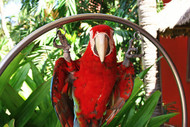Scarlet Macaw Fact Sheet
Posted by Scarlet Macaw Facts, Scarlet Macaw, Scarlet Macaw Diet, Scarlet Macaw Behaviour, Scarlet Macaw Training, Fact Sheet on 9/1/2024
Rosemary Low tells us more about the Scarlet Macaw.
Adult length
About 90cm (36in) including long tail feathers which measure up to 60cm (24in). Size decreases from north to south of the range, Central American birds being largest and those from southern Brazil smallest.
Adult weight
Approximately 1,000g.
For everything you need for your Scarlet Macaw please click here.
Sub-species
Ara macao cyanoptera is distinguished from the nominate race by the yellow median and secondary wing coverts being tipped with blue and lacking the green band that separates the yellow area from the blue tip. In A. m. macao, all yellow feathers with blue tips have a green band separating yellow and blue.
Overall appearance of the wing of Ara macao cyanoptera is one with little or no green. Individuals of nominate race have varying amounts of green. Breeders must make an effort not to pair together the two different sub-species due to the endangered status of cyanoptera.

Young birds
Have greyish eyes, grey lower mandible and a shorter tail than adults.
Suitability as a pet
Due to their large size, loud voices and destructive habits, the large Macaws cannot be recommended as companions in the home unless the owner can provide an aviary into which the Macaw can go during the day, for flight and environmental enrichment. Even so, disturbance to close neighbours must be borne in mind due to the noise level.
For our choice of cages please click here.
A further consideration is the temperament of the Scarlet Macaw which is normally less affectionate and amiable than the Blue and Yellow or Green-winged Macaws.
Potential lifespan
About 55 years.
Availability
Less readily available than the Blue and Yellow and Green-winged Macaws and much more expensive. Must not be sold or bought without Exemption Certificate: on Appendix I of CITES.
Origin
Parts of Mexico, Central America, northern Colombia, the Guianas and various areas of Brazil.
Status in wild
The Central American form is declining so fast in the small countries in which it occurs, that it is in serious danger of extinction. It is already extinct in some parts of its range — probably in the majority of its historic range. Its numbers are decreasing throughout its large range, mainly due to loss of habitat. Killing these Macaws for feathers and trapping for the illegal trade still occurs.

The Scarlet Macaw was listed on Appendix I of CITES in 1985, thus acknowledging that it was threatened by trade in wild birds. However, IUCN and BirdLife International place the Scarlet Macaw in the Least Concern category.
While recognising that it is declining, due to habitat loss and “exploitation” (trapping and poaching), its large range is the reason given for this category. Surely it will not be long before this assessment must be revised.
Trade
One of the most heavily traded populations of Scarlet Macaws was that in Mexico. During 1981 to 1992, before the USA passed the Wild Bird Conservation Act (WBCA), 2,148 Scarlet Macaws were legally imported into the USA. (We can guess that this meant at least 10,000 had been captured, allowing for mortality and illegal export).
But when one market closes, others open. So the capture of Scarlet Macaws and their chicks continued but on a reduced scale thanks to a law to stop the capture of wild-caught Parrots and to prohibit the export of Mexican Parrots that came into effect on October 14 2008.
The government then published a 57-page action plan in December 2009 entitled Programa de acción para la conservación de la especie Guacamaya roja (Ara macao cyanoptera).
Conservation
A strong education programme in Mexico to discourage people from buying wild-caught Parrots is proving successful. In Central America poaching is still a serious problem. In Costa Rica and in Chiapas, Mexico, captive breeding for release into the wild has been occurring with some success.
As aviary birds
Scarlet Macaws need a strong and spacious aviary, a minimum of 6m (20ft) long, 3m (6ft) wide and 2.4m (8ft) high. Welded mesh used should be 10g or stronger. An enclosed building in which they can be shut at night is important to reduce the likelihood of neighbours complaining about the noise level early in the morning.
Here are our choice of cages.
Diet
Nuts are not a luxury in a Scarlet’s diet: they are an essential. Walnuts, almonds and Brazil nuts are excellent (and expensive); pecans and macadamias are also good.
Nuts have been described as the perfect food (for humans) and the fact that some species of Macaws and Parrots eat little else tells us that they are also a perfectly balanced food for these birds.
Nuts have a very high energy content. Depending on the season, many wild Parrots must fly long distances daily to find their food, thus they use up a lot of energy.

